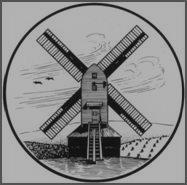
News and Restoration





5th December 2019 - Bolter progress
In 2019 work has continued on the Bolter, which is nearing completion. Roger Bishop has generously donated his time and expertise for the cost of materials.
Summer 2019
A substantial number of boards are being replaced on the roundhouse roof by our carpenter Dan Card. These are tapered boards, so to prevent gaps between the
boards, they need to be allowed to shrink in situ for at least six months. In the spring of 2020, the board ends will be tapped to take up any shrinkage, and finally
trimmed to length.
19th March 2007 - Bolter progress
The bolter has now been installed in the mill after some manoeuvring involving enlargement of the hole! The hopper frame has been built; this was very difficult due
to the angles involved and the cramped access. In the end though it is a good fit, but we have not installed it yet as we are currently working on the rear bearing
mount frame, which would be impossible with the hopper in position. As can be seen in the photo, the shaft has been temporarily installed; this will enable us to
position the rear bearing. Part of the rear bearing frame is an original piece which will be the only original part; it was luckily still in situ even though the remainder of
the bolter had disappeared.




The bolter in position at the rear of the stone floor
on March 11th.
As viewed from below.
Compare this to the photo of the void below.
23rd July 2006 - Bolter progress
We have almost finished manufacture of the main feed hopper, which just needs the entry hatch cut out. The hopper has been moved temporarily to the spout floor
as we are struggling with room in the roundhouse.
The main bolter shaft is now nearing completion so we have turned our attention to the fitting of the bolter in the rear of the stone floor. The old floor, which was
actually only installed in the 1960’s has been removed and a start made on working out how the bolter can safely be bolted within the floor void.

Looking up through the floor void where the bolter will be
mounted.


Looking up through the floor void where the bolter will be
mounted.
The feed hopper (inverted). This
is made from Douglas Fir and is
fully mitred at the corners.
Checking the floor void for squareness is Gordon Hinton,
one of our volunteers.
26th February 2006 - Bolter Progress

The general assembly drawing (AutoCAD)
The bolter is basically a rotating sieve for grading the flour and is the last part of the restoration of the windmill. Although the original bolter was missing, by some
good fortune we still have the remains of the central oak shaft plus a photograph taken in 1955 of the remains in situ, although I have to say that there was not much
there! I knew of a bolter in Keston windmill near Bromley and a visit confirmed that it was almost identical in size and best of all the shaft was exactly the same size.
So after several visits to measure the Keston bolter in detail the work began in November 2003 and is continuing after the production so far of 55 working drawings.



This view shows the lower bearing for the bolting
drum and the hinged door to access the cloth.
The hinged door is yet to be shaped to clear the
rotating bolting drum.
A selection of parts for the bolting drum and
drive.
The oak shaft can be seen on the extreme right
and the steel spindles on the left. The elm drive
pulley is to the rear and the end ring is at the
front.
Again this end will be inaccessible as it will be
very close to the side of the mill.
The bronze bearing for the top end of the bolting
drum can be seen together with the traditional
feed shoe support.


The face on the left will actually be against the rear wall of the mill
once installed and so will not be seen.
The end cover can be seen on the right for access to the bolting cloth
and lower bearing. All of the frame and covers are made of Douglas
Fir.
A close up of the oak dovetail pieces - these are dowelled in place and hold the
end ring together without any glue!



